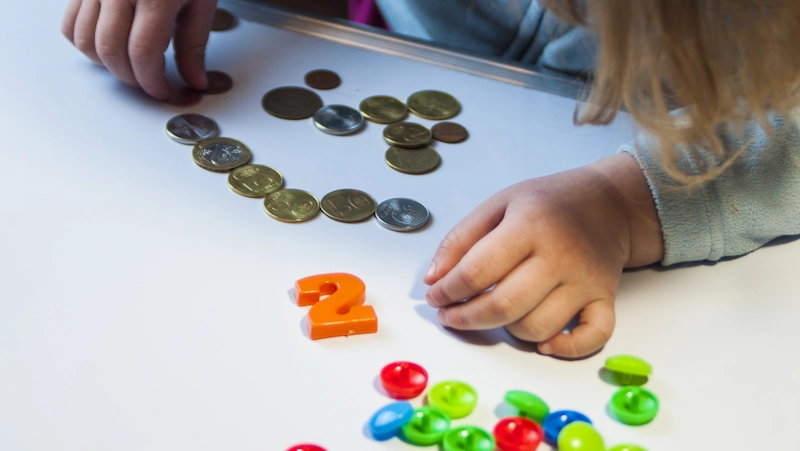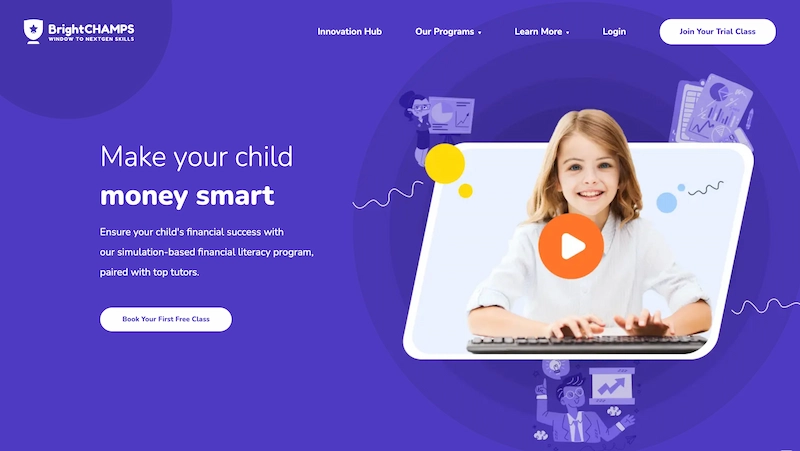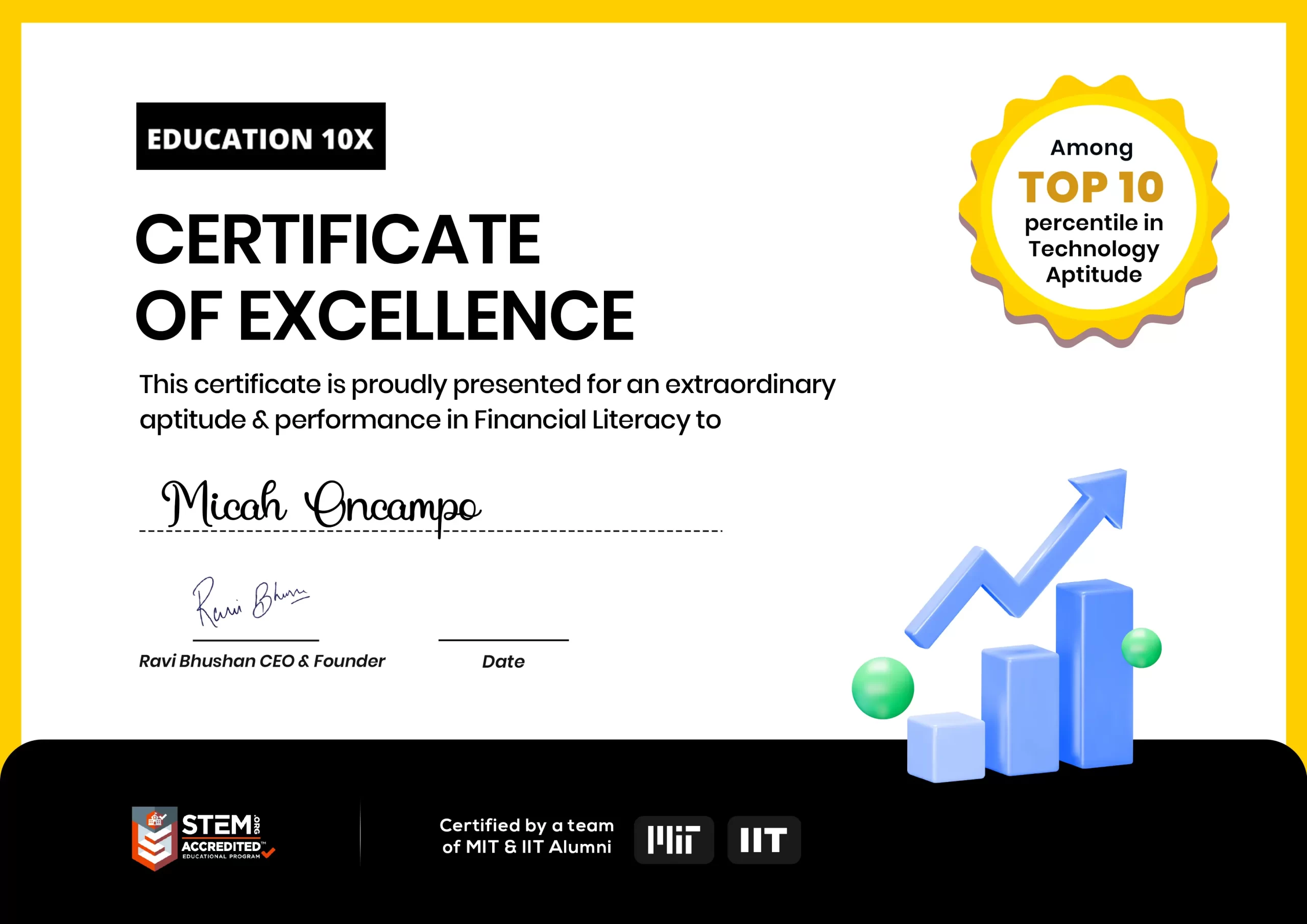Hey there, super-parents and money-savvy champions! Are you ready to embark on an exciting journey toward equipping your little ones with the superpower of financial literacy?
In today’s fast-paced world, where money matters seem to dominate every aspect of our lives, it’s crucial to equip our children with the essential skills to navigate personal financial literacy for kids. Imagine the satisfaction of watching your child confidently count their allowance, make wise spending choices, and even save up for their dreams. The good news? It’s never too early to start!
We understand that teaching financial literacy to kids might seem like a daunting task, but fear not! Our mission is to provide you, the awesome parents, with a treasure trove of tips, tricks, and invaluable resources to make the journey a breeze.
Before diving into the blog, check out this video below.
Join us as we dive into the exciting world of money management for kids, where we’ll break down complex financial concepts into bite-sized, kid-friendly portions. Together, we’ll explore creative and engaging ways to teach your little ones about budgeting, saving, investing, and giving back, all while having a blast along the way!
Let’s dive in and nurture a generation of financial superheroes, one penny at a time!
Table of contents
- The Importance of Financial Literacy for Kids
- Concepts for Teaching Financial Literacy to Kids
- Effective Strategies for Teaching Financial Literacy to Kids
- How to Teach Financial Literacy to Kids?
- Best Resources and Tools for Teaching Financial Literacy to Kids
- Top Websites and Apps for Financial Education
- Recommended Books and Educational Materials
- Supporting Financial Literacy Education at Home and in the Community
- Encouraging Responsibility and Independence through Chores
- Opening a Savings Account and Teaching Financial Planning
- Conclusion
- Frequently Asked Questions
The Importance of Financial Literacy for Kids

Financial literacy is a critical life skill that empowers children to make informed decisions about money, budgeting, saving, and investing. By teaching kids about financial matters early on, we equip them with the tools they need to become financially responsible adults.
Here are a few reasons why financial literacy is essential for kids:
- Building Strong Foundations: Teaching kids about money management from an early age establishes a solid foundation for their financial future.
- Developing Responsible Habits: Financial literacy education helps children develop responsible spending and saving habits, setting them up for a successful financial journey.
- Promoting Financial independence for kids: By understanding financial concepts, children gain the confidence to manage their own money effectively, fostering Financial independence for kids and self-reliance.
Concepts for Teaching Financial Literacy to Kids
To effectively teach financial literacy to kids, it’s important to cover key concepts that form the basis of financial understanding. Let’s explore these concepts in more detail:
1. Budgeting
Teaching kids about budgeting is crucial for instilling responsible money management skills. A budget helps children understand the importance of planning, setting financial goals, and allocating money for different purposes. Encourage kids to create a budget by allocating a portion of their allowance or earnings to savings, spending, and giving.
2. Saving and Investing
Introducing the concept of saving and investing to children can pave the way for a secure financial future. Teach them the value of saving money for short-term goals, such as buying a toy, as well as long-term goals, such as funding a college education or starting a business. Additionally, explain the basics of investment and how it can grow their savings over time.
3. Earning Money
Teaching children the importance of earning money helps them understand the connection between work and financial rewards. Encourage kids to take up age-appropriate tasks or responsibilities that earn them money, such as household chores, tutoring, or running a small business. This instills a sense of work ethic and financial independence from an early age.
4. Needs vs. Wants
Differentiating between needs and wants is a fundamental aspect of financial literacy. Teach children to identify essential needs, such as food, clothing, and shelter, versus discretionary wants, such as toys or entertainment. This understanding helps them make thoughtful spending choices and prioritize their expenses.
5. Banking and Financial Institutions
Introduce kids to the concept of banking and the role of financial institutions. Teach them about savings accounts, checking accounts, and the importance of responsible banking practices. Explain how interest works and how they can benefit from saving money in a bank.
6. Giving Back
Encouraging children to give back to their community cultivates a sense of empathy and social responsibility. Teach kids about charitable giving and involve them in age-appropriate financial literacy activities for kids. This fosters a well-rounded understanding of financial literacy, emphasizing the importance of sharing and making a positive impact.
Effective Strategies for Teaching Financial Literacy to Kids

The capacity to comprehend and handle money is known as financial literacy. Everyone should be able to use it in daily life, but children in particular need to learn it. Financially educated children are more likely to make sensible decisions as adults, which can aid in goal achievement and ensure a stable financial future.
There are numerous efficient strategies for imparting financial literacy to children. Here are some:
Strategy One: Introduce the Concept of Money
As parents or educators, it’s essential to introduce the concept of money and its value to children at a young age. Use play money or create a simple allowance system to teach kids how money is earned, saved, and spent. Encourage them to set savings goals, such as purchasing a toy or saving for a special outing. This hands-on approach will help children understand the real-world implications of money and the importance of managing it wisely.
Strategy Two: Teach Budgeting
Teaching kids about budgeting is a valuable skill that will serve them well into adulthood. Explain the concept of budgeting in a child-friendly manner, using examples they can relate to, like allocating money for toys, treats, and other financial literacy activities for kids. Encourage them to divide their allowance into different categories, such as spending, saving, and giving to charity. This practice will instill the habit of planning their finances and making conscious spending choices.
Strategy Three: Introduce Basic Banking
Introducing the idea of a savings account can teach kids about the banking system and the benefits of saving money in a secure place. Take them to the bank and explain how deposits work, how interest grows their savings over time, and the importance of keeping money safe. Many banks offer special savings accounts for children, complete with fun incentives and educational materials to encourage saving.
Strategy Four: Encourage Entrepreneurial Spirit
Foster an entrepreneurial mindset by encouraging kids to explore simple money-making opportunities. Whether it’s a lemonade stand, selling handmade crafts, or offering services like pet sitting or lawn mowing, these experiences can teach valuable lessons about earning, expenses, and profit. Moreover, it nurtures creativity, responsibility, and perseverance in young minds.
Strategy Five: Use Age-Appropriate Resources
Utilize age-appropriate resources, such as financial literacy games for kids, financial literacy books for kids, and online platforms, that promote financial literacy in an enjoyable way. Many board games are designed specifically to teach kids about money management and decision-making. Financial literacy books for kids that illustrate financial concepts with relatable characters and scenarios can also make learning more engaging. Interactive apps and online platforms can further reinforce financial literacy skills through quizzes, challenges, and simulations.
Strategy Six: Incorporating Interactive Activities and Games
Kids may learn about financial literacy through a variety of interactive financial literacy games for kids and activities. Several instances include:
- Kids can learn how to make and adhere to a budget by playing these games. Both online and offline, there are a wide variety of budgeting for kids games to choose from.
- Savings games: These activities can teach young people the value of saving money. Financial literacy games for kids for saving money come in a variety of forms, including piggy banks and coin jars.
- Playing financial games may teach children the fundamentals of investing. Both online and offline, there are many different investing games to choose from.
You can check out the following interactive games that are available online to help your kids with financial literacy:
- Cash Puzzler
Put the pieces of the puzzle back together to complete the image of a dollar bill. Choose between puzzles and learn fun facts about money. - Christmas Money Game
Children are presented with a gift and the cost associated with purchasing the gift. Next to it is pictured the money they have and select whether they have enough. - Kids’ Finance Word Search
Play a money-themed word search game, and build your financial vocabulary. - Peter Pig’s Money Counter
In this interactive game, kids practice identifying, counting and saving money while learning fun facts about U.S. currency. - Rich Kid Smart Kid
Financial lessons with fun video game characters is the best way to learn how to be smart with your money!
There are plenty of additional ways to teach youngsters about financial literacy besides interactive activities and financial literacy games for kids. Kids can learn about money from their parents and teachers, and they can give them the opportunity to do so through practical situations.
As an illustration, parents can accompany their children to the bank and demonstrate how to make deposits into their accounts. They can also show their children how to keep track of their expenditures and assist them in opening a savings account.
Kids can learn about financial literacy in a fun and interesting way by including interactive activities and games in the learning process. This can assist kids in acquiring the knowledge and abilities necessary to make wise financial decisions throughout their lives.
Instructional Materials for Financial Litercay for Kids
Children can learn financial literacy in a variety of ways. Giving them thorough educational materials is one method to help. Financial literacy books for kids, websites, applications, and financial literacy games for kids are all examples of these types of resources. They should cover a wide range of financial subjects, including budgeting, saving, investing, and credit, and they should be engaging and age-appropriate.
Talking to children about money is another approach to instilling financial literacy in them. You can do this in a relaxed situation, like at the dinner table. Parents can help their children make sensible financial decisions by sharing their own financial experiences with them.
Finally, through engaging in practical financial activities, children can also learn about financial literacy. This can entail starting a savings account, finding employment, or getting a credit card. Children can learn money management skills and how to make wise financial decisions from these experiences.
A wonderful strategy to teach children financial literacy is to provide them with thorough instructional materials, including books, games, and online resources. These resources can teach children the fundamentals of financial management and aid in the development of the skills necessary for making sound financial decisions, ultimately preparing them for concepts like opening a bank account for kids as they grow older.
Here are a few particular instances of thorough educational materials that can be utilized to train children about financial literacy:
- Books: There are many excellent books that teach children financial literacy. A few well-liked financial literacy books for kids are “The Berenstain Bears and the Trouble with Money,” “The Total Money Makeover for Teens,” and “Money Smart Kids.” These books are also great way to teach financial literacy for teens.
- Websites: There are many excellent websites that provide children with resources for financial literacy. The Consumer Financial Protection Bureau (www.consumerfinance.gov), The Jump$tart Coalition for Personal Financial Literacy (www.jumpstart.org), and The National Endowment for Financial Education are a few well-known websites.
- Apps: Many excellent apps are available that instruct children in financial literacy. A few well-known apps are “Mint Money Manager,” “Learn to Save Money,” and “Financial Literacy for Kids.”
- Games: Kids may learn about financial literacy by playing a variety of fantastic games. A few well-liked games are “The Lemonade Stand,” “The Stock Market Game,” and “The Financial Literacy Game.”
- These are but a few illustrations of the numerous thorough educational resources that may be used to school children in financial literacy. By giving children access to these resources, we can assist them in acquiring the knowledge and abilities necessary to make sound financial decisions and succeed financially.
How to Teach Financial Literacy to Kids?

Teaching financial literacy to children may be easier than you think. However, make certain that you do not misunderstand this for teaching children complicated financial terms.
No! Instead, as a parent, you can teach your children about money through simple yet practical lessons at home.
We understand that kids of different ages have different ways of perceiving knowledge, and so in this blog, we have broken everything down into two parts, which provide you with information on financial literacy activities for elementary students and financial literacy for kindergarten, including learning money for kids.
Financial Literacy for Kindergarten (Age 2-7 years)
This section will guide you on how to give advice, lesson plans, and activities to children between the ages of four and seven as they are introduced to the foundational ideas of early financial literacy. Financial literacy for kindergarten is extremely crucial to instill wise financial behavior in these young minds.
Let’s break it down into a few easy steps.
- Lesson One: Making Spending Decisions
When toddlers are given the freedom to make simple judgments, they will find it easier to make decisions on their own as they get older. Therefore, it’s crucial to establish structured, financial decision-making activities for preschoolers and kindergarteners.
- Lesson Two: Spending Plans
Early guidance in categorizing money creates patterns for later behavior related to money management. Introduce the idea of separating their money into “save,” “spend,” and “sharing” categories to your kids gradually. Later on in this blog, you can learn about many activities that teach kids that there is a finite amount of money and that it needs to be distributed among various uses.
- Lesson Three: Earning Money
Children need to understand that money must be earned and does not come easily at this stage. A foundation and knowledge that work and money are linked are built through early practice earning tiny sums of money. Even though such a concept is crucial to financial literacy for teens but it should also be taught to kids from an early age.
Just by virtue of being a member of the family or household, young children are required to complete some responsibilities at home. Children can perform additional jobs to generate additional income for their budgets. Children need to understand the difference between duties that earn them money and duties that they share as family members.
- Lesson Four: What is Money?
The names and values of the various coins and bills that are used to pay for products and services must be known to children. Children learn the names of coins at this stage, as well as their respective worth in terms of purchasing power.

Financial Literacy for Elementary Kids (Age 7-11 years)
The major difference between how kids in kindergarten think financially differently from kids in elementary school is that they are already capable of managing money in small amounts, so they have a pre-conceived notion about money-related matters and what becomes important as a parent is to make sure that they direct their knowledge in the right direction, laying a solid foundation in finance for kids.
So let’s look at the steps that come in this regard!
- Step 1: Budgeting
You might think that the first step would be to teach children about earning, but this is not the case because children need to learn how to save and segregate their spending plans wisely.
You must first teach them budgeting because it is one of the most important aspects of financial management.
We are all aware of how bad or no budgeting leads to financial problems.
So sit down with your children and teach them how to divide their earnings for various purposes to achieve financial freedom since it’s the first step in providing financial literacy activities for elementary students
- Step 2: Money Responsibility
Keeping track of your spending is essential for effective money management. Knowing how much money is available, how much money has been spent, and how much money needs to be saved for future requirements are all part of this. This phase is crucial for introducing elementary-aged kids to the idea of being accountable for managing money by keeping correct records.
The first step in teaching your child about money is to teach them about earning, or how people make money.
- Step 3: Earning
You can accomplish this by assigning them simple tasks or errands in exchange for monetary compensation.
This activity will help them understand the earning process. If this activity is instilled in children as young as seven, they will learn about earning in no time.
- Step 4: Saving
Saving is an important part of financial management and financial literacy.
When it comes to securing our financial future, we cannot overstate the importance of saving.
As a result, we must teach our children this lesson. When budgeting, teach them to set aside a portion of their money for savings.
You can even act as their bank, earning interest on their savings. This way, you can teach them about bank savings accounts.
- Step 5: Investing
Investing, like budgeting and saving, is an essential component of financial management. If we want a financially secure future, we must invest.
Though children cannot physically invest, you can make plans at home for them to do so, so that they understand how it works on a basic level.
- Step 6: Spending Wisely
It is literally the last thing you should teach your children when it comes to financial literacy.
Because they may already have a hazy idea of how to spend the money or how it works.
However, as the final step in teaching financial literacy at home, you must teach them how to spend their money wisely and how reckless spending leads to financial problems, instilling good habits for kids early on in their financial journey.
Leveraging Technology and Virtual Reality
When used effectively, technology can help teach children financial literacy. Kids may learn about saving, investing, and other financial ideas by playing a variety of instructional games and applications.
These games and applications may make learning about money interesting and exciting, which can aid children in remembering the material. Another innovation that has the potential to revolutionize finance education is virtual reality (VR).
Virtual reality (VR) can give children a secure, regulated environment in which to explore real-world financial scenarios. Kids may use virtual reality to practice creating bank accounts, purchasing cars, or investing in stocks, for instance. Kids who receive this kind of practical education are more likely to comprehend the effects of their financial decisions and make wiser judgments in the future.
Technology may be utilized in a variety of ways to teach kids financial literacy. Here are a few illustrations:
- Games and apps for education: There are many games and apps for education that can teach children about financial literacy. These games and applications may make learning about money interesting and exciting, which can aid children in remembering the material.
- Children can learn about the stock market and how to invest in the future by playing the game Money Monster.
- The Lemonade Stand: This game instructs young players about business management and entrepreneurship.
- Virtual reality: Another innovation that has the potential to revolutionize finance education is virtual reality (VR). Virtual reality (VR) can give children a secure, regulated environment in which to explore real-world financial scenarios. Kids may use virtual reality to practice creating bank accounts, purchasing cars, or investing in stocks, for instance. Kids who receive this kind of practical education are more likely to comprehend the effects of their financial decisions and make wiser judgments in the future.
- Examples of VR Financial education for kids experiences include:
- Kids may tour a virtual bank and discover various financial goods and services through the VR experience VR Bank.
- Kids can learn about the stock market and practice trading stocks in this virtual reality experience.
- VR Entrepreneurship: Through this VR experience, children may launch and manage their own virtual company.
Financial Literacy for Middle School Kids (Age 11+years)
Middle school is a crucial phase in a child’s development, and it is the perfect time to introduce them to the world of financial literacy. As kids approach their pre-teen years, they become more independent and begin to make small financial decisions. Equipping them with essential financial knowledge at this stage, including financial education for kids, will empower them to make responsible choices and build a strong financial foundation for their future. Here are some valuable lessons to teach financial literacy to middle school kids:
Lesson 1: Money Management Basics
Introduce the concept of money management by explaining the difference between needs and wants. Teach them to prioritize essential expenses like school supplies and food over non-essential items like toys or gadgets. Help them set up a simple budget, allocate their allowance or gift money into different categories, and encourage them to track their spending.
Lesson 2: Saving for Goals
Teach kids the importance of setting financial goals and saving towards achieving them. Whether it’s buying a new bike, saving for a school trip, or a future college fund, setting specific goals will instill discipline and patience in their saving habits. Encourage them to create a savings jar or open a savings account to watch their money grow.
Lesson 3: Understanding Interest
Introduce the concept of interest and its role in savings and loans. Explain how compound interest can make savings grow faster over time and how it can work against them when borrowing money through loans or credit cards. This lesson will help them grasp the benefits of saving early and the potential pitfalls of accumulating debt.
Lesson 4: Responsible Spending
Teach kids to be mindful of their spending habits and to make informed purchasing decisions. Encourage them to comparison shop, research before buying, and avoid impulsive purchases. Discuss the value of delayed gratification, emphasizing the rewards of saving up for something they truly desire.
Lesson 5: Identifying Scams and Frauds
Raise awareness about financial scams and frauds that can target young individuals. Teach them to be cautious about sharing personal information online and the importance of verifying the credibility of online offers and websites. Educate them about phishing emails, fraudulent phone calls, and other common scams.
Best Resources and Tools for Teaching Financial Literacy to Kids

To assist parents in educating their children about money, there are numerous resources and instruments available. The following are some of the greatest sources:
- Novels: Kids may learn about money from a variety of excellent novels. Popular books include “How to Make Your Own Money” by Laura Numeroff, “The Money Tree” by Eric Litwin, and “The Berenstain Bears’ Trouble with Money” by Stan and Jan Berenstain.
- Websites: There are a lot of websites that provide youngsters with resources for financial literacy. Several well-known websites include:
- The National Endowment for Financial Education (NEFE) is a nonprofit organization that provides lesson plans, games, and other tools for children.
- The JumpStart Coalition for Financial Literacy: The JumpStart Coalition provides youngsters with a range of materials, such as games, exercises, and lesson plans.
- The Sesame Street Workshop: The Sesame Street Workshop provides a range of educational materials for youngsters, such as lesson plans, games, and activities.
- Numerous apps are available that instruct children about money. Popular applications include:
- Greenlight: Greenlight is a debit card for children that includes an app for parents that enables them to supervise their spending.
- BusyKid: BusyKid is a kid-friendly debit card that comes with a parent app so that parents can supervise their children’s spending.
- RoosterMoney: This kid-friendly debit card comes with a parent app that enables parents to supervise their children’s spending.
Parents can assist their children in learning about money by talking to them about it in addition to using resources and tools, including online games for kids. Parents can explain to their children how they make money, spend money, and save money. Parents can also discuss with their children the value of setting aside money for savings and investing.
Top Websites and Apps for Financial Education

No matter what your age, income level, or level of education is, everyone has to be financially literate. You may reach your financial objectives, make wiser financial decisions, and save money with its assistance. You may learn about personal finance through a variety of methods, including websites and applications.
Some of the best websites and apps for Financial education for kids are listed below:
- Brightchamps offers various financial literacy class for kids to choose from in their program “FinChamps”. In order to get the best possible results for learning, the curriculum has been designed specifically for each age range. The platform gives children access to an incredible variety of resources and materials, which enables them to construct a strong foundation in personal financial literacy for kids.
- A free service called Personal Capital allows you to keep tabs on your investments, spending, and budget. Additionally, a wide range of educational tools are provided, such as articles, videos, and calculators.
- Another free website that aids in tracking your expenses is Mint. Additionally, it provides a selection of financial guidance and budgeting tools.
- A website called NerdWallet offers information and financial guidance. It provides tools, calculators, and articles to aid in better financial decision-making.
- The website Investopedia offers educational materials about investing. On a range of investing-related topics, it provides articles, videos, and financial literacy course for kids.
- A nonprofit organization called Khan Academy offers free educational materials on a range of subjects, including personal finance, including videos, essays, and activities.
- Sense and Dollars is an interactive website for kids where they can learn everything there is to know about money. This website contains a variety of enjoyable games in which students can learn about earning, spending, and saving. Each of these sections, earn, spend, and Save, has its own game where kids go on a journey to learn about money.
- Money Sense is a free Financial education for kids program that teaches children about money through financial literacy class for kids, games, and financial literacy activities for kids. The entire website, which caters to children aged 5 to 18, is divided into four major age groups: 5-8, 8-12, 12-16, and 16-18. Each section has its own visual style, which makes the lessons and games enjoyable for anyone who signs up.
- Bankaroo is one of the best platforms for teaching children about money management. It is a virtual bank for children, which means that they can open accounts to track their earnings, expenses, and savings. Parents can easily teach their children about budgeting by using Bankaroo. Children can keep track of their monthly allowance, review previous transactions, and even transfer funds to other children.
- Hands-on Banking, sponsored by the American multinational financial services company Wells Fargo, offers free financial literacy materials such as videos and articles that are simple to understand. The site is primarily aimed at young adults and older children, and it covers topics ranging from college student loan comparisons to using credit cards wisely and paying taxes.
Recommended Books and Educational Materials

Everyone should be able to manage their finances, and it’s never too early to start teaching children about money. Financial literacy is a crucial life skill. There are many excellent books and educational resources available that can give kids a fun and interesting approach to learning about financial principles.
Some preferred financial literacy books for kids and educational resources for educating children about financial literacy are listed below:
- The popular book The Berenstain Bears’ Dollars and Sense by Stan and Jan Berenstain teaches young readers the fundamentals of setting a budget, saving money, and making purchases.
- The Four Money Bears by Mac Gardner is a humorous and entertaining book that teaches young readers about various monetary personalities.
- Ron Lieber’s book The Opposite of Spoiled teaches young readers the value of being thrifty and giving to others.
- By Beth Kobliner, author of Make Your Kid a Money Genius (Even If You Ain’t): This book is a thorough resource for educating children on all facets of personal finance.
- The Kids’ Money Book by Brette Sember is a handy guide for teaching children about money.
To assist children in learning about personal financial literacy for kids, there are many excellent educational resources available in addition to financial literacy books for kids. Listed here are some of the best ones:
- Parents and instructors can find various tools on the personal financial literacy for kids website from the National Financial Educators Council, including games, financial literacy activities for kids, and financial literacy class for kids.
- Kids can find a range of materials on the website of the JumpStart Coalition for Personal Financial Literacy, including games, financial literacy activities for kids, and films.
- Kids can find a range of educational games and financial literacy activities for kids on the Khan Academy Kids app, some of which are geared toward financial literacy.
- Financial literacy education for children is a crucial investment in their future. You can help kids acquire the knowledge and skills necessary to make wise financial decisions throughout their lives by getting them started young.
Supporting Financial Literacy Education at Home and in the Community

People who are financially literate are more likely to make wise decisions, save money, and reach their goals.
There are several approaches to supporting community and home-based financial literacy education. Here are some suggestions:
- Discuss money with your children. Start by outlining fundamental ideas like earnings, spending, and saving. As they get older, you can discuss more advanced subjects like credit, investment, and budgeting.
- Lead by example. Children pick up lessons from the elders in their lives. Make sure you are setting a good example by making sound financial decisions yourself if you want your children to be money-wise.
- Participate in your neighborhood. Numerous organizations provide financial literacy course for kids. Participate in your neighborhood and give these programs your support.
- Make use of the internet. There are a tonne of excellent internet resources that can assist you in educating your children about money management. Visit the websites of the Consumer Financial Protection Bureau, the Federal Reserve Bank of New York, and the National Endowment for Financial Education.
Everyone should be able to manage their finances, which is a crucial life skill. We can ensure that everyone has the chance to achieve financial success by promoting financial literacy education at home, in the community, and through fun & educational activities for kids.
Encouraging Responsibility and Independence through Chores

Financial independence for kids and responsibility can be learnt through chores. They also assist children in developing financial literacy. Kids who help out with chores learn the value of working hard and making money. They also learn time and money management skills.
Children can perform a wide variety of chores. Making their beds, cleaning their rooms, putting out the garbage, and doing the dishes are a few typical duties. Children can be trusted to do errands or assist with garden maintenance.
Make sure that the chores you give your children are appropriate for their age when you allocate them. Additionally, make sure that the chores are distributed fairly. Nobody ought to be forced to perform all the work.
It’s also crucial to discuss the purpose of chores with children. Tell them that completing chores is a method for them to help out the family and that it will teach them useful skills. Money lessons for kids taught to them in this form can be very beneficial.
Children can learn about financial literacy through chores. Kids learn about the value of money when they receive payment for doing chores. Additionally, they pick up money management skills and how to save for desired purchases.
Here are some more pointers for educating youngsters about money management through chores:
- Start by giving them manageable, easy-to-complete modest chores.
- You can give older kids more difficult chores as they get older.
- Ensure the chores are suitable for the child’s age.
- Even a tiny payment for chores performed by children should be made.
- The value of money and budgeting should be discussed with children.
- Help children set financial objectives.
- Set an example for others by handling your own finances responsibly.
- You can assist your children in learning about financial literacy and acquiring the abilities required to become financially responsible adults by using the advice in this article.
Opening a Savings Account and Teaching Financial Planning

Opening a savings account for your children is one approach to teaching them about financial literacy. They can learn the value of saving money and how to make it grow as a result of this. It’s critical to pick a savings account with low fees and attractive interest rates when setting one for a child.
Know more about computer coding for kids. Learn here!
Talking to children about money is another approach to instilling financial literacy in them. Describe the distinction between wants and requirements and assist them in creating a budget. Help them develop financial goals and educate them on the value of saving for the future.
Conclusion
To sum up, financial literacy is a crucial life skill that can be advantageous for kids of all ages. Parents can aid their kids in forming lifelong financial habits by teaching them about money. Parents can teach their kids about money using a variety of materials. These sources include educational games, websites, and books, among others. Parents may help their kids lay a solid financial foundation for the future by taking the time to teach them about money.
To get your hands on more educational and free resources on coding for kids, robotics for kids, financial education for kids, etc., do check out the BrightCHAMPS Page now!
Finchamps by BrightChamps is an extraordinary learning program that ignites children’s financial skills through a unique blend of innovation and creativity. With FinChamps, children not only acquire practical skills but also cultivate a mindset of financial responsibility. They develop an understanding of the value of money, learn to make informed decisions and build a foundation for a secure financial future. Through its engaging and interactive approach, FinChamps provides an invaluable learning experience that empowers kids to become financially savvy individuals.
Frequently Asked Questions
Q1: How do I teach my 5 year old financial literacy?
A1: Introduce fundamental ideas such as coin identification and value, the use of piggy banks, playing games with money, and a straightforward discussion of saving and spending behaviors.
Q2: What is the definition of financial literacy for children?
A2: Children’s financial literacy is the ability to make wise financial decisions and efficiently manage their resources. It is the knowledge and comprehension of financial ideas, skills, and behaviors.
Q3: At whatj age should kids learn about financial literacy?
A3: Although training on financial literacy should start as early as feasible, they can start around the age of 5 or 6.
Q4: Why is it important to teach kids financial literacy?
A4: To provide children with the knowledge and abilities required to make wise decisions, handle money wisely, and safeguard their financial future, financial literacy education is crucial.
Q5: Should kids be taught financial literacy?
A5: Yes, financial literacy should be taught to children. It gives them the knowledge and abilities they need to make wise decisions and efficiently manage their finances for the rest of their lives.
Q6: How do you teach kids the value of money?
A6: Giving children practical experiences, leading by example, and giving them chances to earn and save money are all effective ways to teach them the value of money.

 We are an army of educators and passionate learners from BrightChamps family, committed to providing free learning resources to kids, parents & students.
We are an army of educators and passionate learners from BrightChamps family, committed to providing free learning resources to kids, parents & students.








